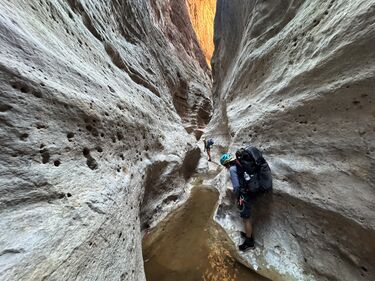150 Mile Canyon
Jump to navigation
Jump to search
Also known as: 150-Mile Canyon.
| Rating: | |||||||||||||||||||||||||||||||
|---|---|---|---|---|---|---|---|---|---|---|---|---|---|---|---|---|---|---|---|---|---|---|---|---|---|---|---|---|---|---|---|
| | Difficulty:3B VI (v3a2 VI) Raps:max ↨50ft
Red Tape:Permit required Shuttle: | ||||||||||||||||||||||||||||||
| Location: | |||||||||||||||||||||||||||||||
| Condition Reports: | 25 Apr 2025
"Did in combination with Panameta.. Beautiful narrows just go on and on! The scale in insane! Great life in there too. Takes a lot of time to h |
||||||||||||||||||||||||||||||
| Best season: | Spring;Summer;Fall
|
||||||||||||||||||||||||||||||
| Regions: | |||||||||||||||||||||||||||||||
Introduction[edit]
Approach[edit]
Descent[edit]
Exit[edit]
Red tape[edit]
Permit required at all times.
The overnight permit Use Area for 150-Mile Canyon is LB9.
Beta sites[edit]
 Super Amazing Map : 150 Mile Canyon
Super Amazing Map : 150 Mile Canyon Grand Canyoneering Book by Todd Martin : 150-Mile Canyon
Grand Canyoneering Book by Todd Martin : 150-Mile Canyon
Trip reports and media[edit]
 Ram on Canyon Tales : 150 Mile, Matkat, Panameta, Olo
Ram on Canyon Tales : 150 Mile, Matkat, Panameta, Olo
EVEN FURTHER - 150 MILE CANYON
